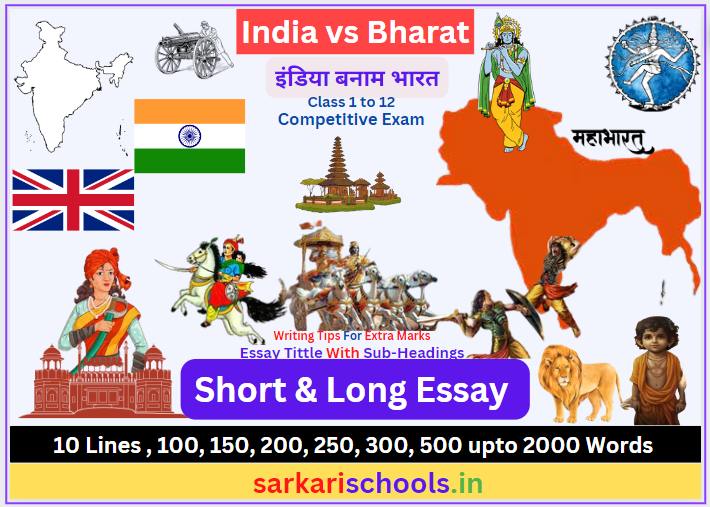Explore the intriguing dual identity of India vs Bharat – two names, one nation. Delve into the historical, cultural, and linguistic nuances shaping India’s unique character.
Table of Contents

India vs Bharat
The Origin and Significance of the Name ‘Bharat’
The name “Bharat” has deep historical and cultural significance in India. It is derived from ancient Indian texts, particularly the Vedas, Puranas, and epics like the Mahabharata. Here are all the details about the origin and significance of the name “Bharat”:
- Etymology: The name “Bharat” is derived from the Sanskrit language, which is one of the oldest languages in the world. In Sanskrit, “Bharat” (भारत) is pronounced as [bhaa-ra-t], and it is spelled as “भारत” in the Devanagari script.
- Mythological Origin: The name “Bharat” finds its origin in ancient Indian mythology and epics. It is closely associated with King Bharata, who is a legendary figure mentioned in various ancient texts, most notably in the Mahabharata and the Puranas.
- Mahabharata: In the Mahabharata, Bharata was a son of King Dushyanta and Queen Shakuntala. He was a renowned monarch and is considered the founder of the Bharata dynasty. His story is a central part of Indian mythology and is celebrated for its themes of justice, duty, and valor.
- Historical and Geographical Significance: Over time, “Bharat” came to represent the entire Indian subcontinent in many ancient texts. It was used to refer to the vast region encompassing present-day India, as well as parts of Pakistan, Nepal, and Bangladesh.
- Symbolic Meaning: The name “Bharat” holds deep symbolic meaning in Indian culture. It signifies the essence of India’s historical and cultural identity, harking back to its ancient roots. It represents continuity with the past and the enduring values and traditions of the Indian civilization.
- In the Indian Constitution: “Bharat” is officially recognized as the name of the country in Article 1 of the Constitution of India. It states that “India, that is Bharat, shall be a Union of States.” This dual nomenclature reflects India’s commitment to acknowledging its ancient heritage and modern identity.
- Cultural and Linguistic Usage: In contemporary India, “Bharat” is often used in native languages, particularly Hindi, when referring to the nation in a more traditional and cultural context. In contrast, “India” is frequently used in English and international contexts, emphasizing the country’s modern and global identity.
In summary, the name “Bharat” has deep historical and cultural roots in India. It is closely associated with Indian mythology and ancient texts, symbolizing the nation’s rich heritage, traditions, and values. The coexistence of “India” and “Bharat” reflects the multifaceted identity of the country, where the past and present merge to define a diverse and dynamic nation. India vs Bharat
The Origin and Significance of the Name ‘India’
The name “India” has a rich history, and its origin can be traced back to ancient times. Here are all the details about the origin and significance of the name “India”:
1. Etymology: The name “India” is derived from the word “Indus,” which is itself derived from the Old Persian word “Hinduš,” referring to the Indus River. The Greeks, who encountered this region through Alexander the Great’s campaigns, referred to it as “Indía.”
2. Ancient Usage: The term “India” was used by various ancient civilizations to refer to the land beyond the Indus River. It first appeared in Western literature in the works of Herodotus in the 5th century BCE and later in the writings of other Greek historians and geographers.
3. Sanskrit Equivalent: In ancient Sanskrit texts, the region corresponding to modern-day India was known as “Bharatvarsha” or “Bharat.” However, the name “India” gained prominence in Western cultures due to the influence of Greek and Roman writings.
4. Historical Significance: India has a rich and diverse history that spans thousands of years, and the name “India” reflects its historical significance as one of the world’s oldest and most culturally diverse civilizations.
5. Colonial Era: During the colonial period, the Indian subcontinent came under British rule, and the British Empire referred to it as “India.” The term “British India” was commonly used to describe the region under British colonial administration.
6. Post-Independence: After gaining independence from British rule in 1947, the newly formed nation retained the name “India.” The name was officially adopted as the “Republic of India” when the Indian Constitution came into effect on January 26, 1950.
7. Linguistic and Cultural Diversity: The name “India” represents the linguistic and cultural diversity of the country, which is home to hundreds of languages, various religions, and a multitude of cultures.
8. Modern Usage: “India” is the internationally recognized name of the country and is used in official and diplomatic contexts. It is also widely used in English and other international languages.
In summary, the name “India” has its origins in the word “Indus” and was popularized by ancient Greek and Roman writers. It reflects the historical and cultural significance of the Indian subcontinent and is now the official name of the country, representing its diverse and dynamic identity.
Conclusion
In conclusion, the distinction between “India” and “Bharat” represents the multi-faceted nature of India’s identity. These two names, with their historical, linguistic, and cultural significance, coexist harmoniously to encapsulate the richness of this nation. “India” symbolizes its modern, global, and outward-facing character, reflecting economic progress and technological advancements. On the other hand, “Bharat” underscores India’s deep-rooted traditions, ancient heritage, and cultural diversity.
The dual nomenclature is more than just linguistic; it is a reflection of India’s ability to embrace its past while looking toward the future. It signifies the unity in diversity that characterizes the country, where myriad languages, cultures, and traditions thrive side by side. Both “India” and “Bharat” are integral to the nation’s identity, showcasing its ability to bridge the gap between ancient traditions and modern aspirations, resulting in a dynamic and multifaceted nation. Embracing both names allows us to appreciate the full spectrum of India’s historical and cultural tapestry.
Extra Tips 4 Extra Marks :
Practice Essay Writing Online
FAQ on India vs Bharat
What is the difference between India and Bharat
Q1: What is the difference between “India” and “Bharat”?
A1: “India” and “Bharat” are two names for the same country, officially known as the Republic of India. “India” is commonly used in international contexts, emphasizing its modern and global identity, while “Bharat” is used more often in native languages, particularly Hindi, to emphasize cultural and traditional aspects.
Q2: Why are there two names for India?
A2: The dual nomenclature reflects India’s complex identity, rooted in both ancient traditions and modernity. “India” represents the nation’s global outlook, while “Bharat” signifies its deep historical and cultural heritage.
Q3: Which name is officially recognized?
A3: Both names are officially recognized in the Indian Constitution. Article 1 states, “India, that is Bharat, shall be a Union of States,” acknowledging both names.
Q4: How are “India” and “Bharat” used in daily life in India?
A4: The usage depends on context and language. “India” is often used in international and formal contexts, while “Bharat” is used in native languages and cultural discussions.
Q5: Are there political or cultural implications to using one name over the other?
A5: Yes, sometimes the choice of name can carry political or cultural implications. “Bharat” may be preferred by some to emphasize traditional values, while “India” may signify a more modern or global perspective.
Q6: Does the choice of name affect the country’s identity?
A6: The coexistence of both names reflects India’s ability to embrace its diverse identity, combining ancient traditions with modernity. The choice of name can emphasize different aspects of this identity but doesn’t fundamentally change it.
Q7: Are there historical origins to these names?
A7: Yes, “India” has historical roots in ancient civilizations along the Indus River, while “Bharat” has its origins in Sanskrit texts like the Mahabharata.
Q8: Can both names be used interchangeably?
A8: Yes, both names can be used interchangeably to refer to the same country. Their usage depends on the context and the speaker’s preference.
Q9: Is there a consensus on which name is more appropriate?
A9: There is no definitive consensus, as the choice of name often depends on individual preferences and contexts.
Q10: How do other countries refer to India?
A10: In international diplomacy and relations, most countries refer to India as “India” or “Republic of India” because it is the globally recognized name for the nation.
Republic of India
India vs Bharat India vs Bharat India vs Bharat




